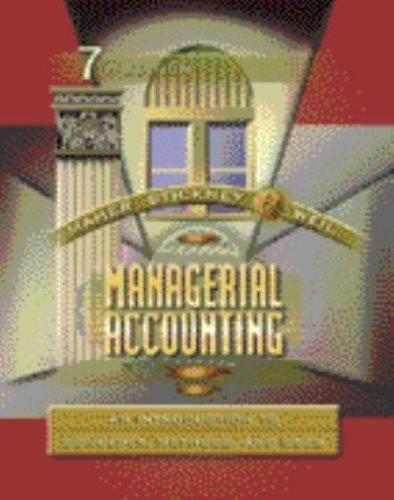Evaluating cost systems used in financial services companies. John Frank, controller of M idwest Insurance Company, recently
Question:
Evaluating cost systems used in financial services companies. John Frank, controller of M idwest Insurance Company, recently returned from a management education program where he talked to Peter Montgomery, his counterpart at Northern Insurance Company. Both companies had mortgage departments, but whereas Midwest made loans only to businesses. Northern made only home mortgage loans.
Peter Montgomery had described the use of standard costs at Northern as follows:
We have collected data over several years that give us a pretty good idea how much each batch of loans costs to process. We receive loans in three main categories: ( I )
FHA and VA mortgages. (2) conventional home mortgages, and (3) development loans. Banks and other financial institutions make these loans initially and hanks then package the loans and offer them to lis as a package. The Mortgage Division establishes terms for ascertaining whether we accept the mortgage and lor legal work on the loan. We assume that each loan in a category costs about the same. To calculate how much processing loans costs, we periodically have people in the Mortgage Division keep track of their time on each package of loans. Our overhead is about 130 percent of direct labor costs, so we assign overhead accordingly to each package of loans. We don't keep track of the actual costs of processing each package of loans.
What we lose in knowing the actual cost of processing each package of loans, we make up by saving clerical costs that we would incur to keep track of the time spent on each package of loans.
A cost statement for a recent month appears in Exhibit 2.
1 3.
Montgomery's comment about saving clerical costs struck a respondent chord with John Frank. Midwest's accounting costs had reached alarming levels, according to the company president, and Frank was looking for ways to reduce costs. Midwest kept track of the following costs for each loan: labor; telephone costs; travel; and outside services, such as appraisals, legal fees, and the cost of consultants. The costs of

processing these loans often amounted to several thousand dollars. A sample of these loans and their processing costs appears in Exhibit 2.14.
When Frank told the Mortgage Division manager about the methods Northern used, the manager responded: "That sounds fine for them because each package of loans in a category has about the same processing costs. The processing costs of each loan in our company vary considerably. I believe it would be invalid to establish standards for our loans."
Frank thought the Mortgage Division manager's comments were reasonable, but he wanted to find some way to save clerical costs by not recording the costs of processing each loan. At the same time, he knew the firm would potentially benefit from having a standard against which to compare actual costs.
a. What would you advise Mr. Frank to do? Compare the advantages and disadvantages of t he system each company uses.
b. Diagram the flow of costs for each company using the data available in Exhibits 2.13 and 2. 14. Treat each loan or category of loans as a separate product in your diagram.
Step by Step Answer:

Managerial Accounting An Introduction To Concepts Methods And Uses
ISBN: 9780030259630
7th Edition
Authors: Michael W. Maher, Clyde P. Stickney, Roman L. Weil, Sidney Davidson





